Walt Disney Pictures/Theodore Thomas Productions (October 20 1995), Walt Disney Home Video (November 18 2003), single disc, 89 mins plus supplements, 1.85:1 anamorphic widescreen, Dolby Digital 5.1 Surround, Rated PG, Retail: $29.99
Storyboard:
The lives, times and works of the two last surviving of Walt Disney’s legendary “Nine Old Men” group of trusted animation geniuses, Frank Thomas and Ollie Johnston.
The Sweatbox Review:
Following on from last year’s release of Walt: The Man Behind The Myth, a limited edition telling of the Disney story produced by his family, comes this earlier release, which covers the same style of ground, but not necessarily the same content, and is also made by a family member. Frank And Ollie, which like Walt was previously only available on pan-and-scan VHS, brings the last two remaining of Walt’s famed “Nine Old Men” to the fore, delving into their histories and detailing their extraordinarily strong friendship.

As the Disney family steered the Walt documentary, and Ub Iwerks’ daughter Leslie directed The Hand Behind The Mouse (another excellent film and one that one would hope will find a DVD audience soon), here it’s the turn of Frank’s son Theodore (as well as producer daughter-in-law Kunico Okubo) to craft the film, and as such, he does so most entertainingly. It’s a very sweet film, though that’s not to say it is slow, saccharine or boring in any way at all – this is a first class examination of two of the finest animators who ever brought a pencil to Disney animation, and a must for animation aficionados everywhere (even if you do already have the VHS, which strangely “flops” the correct front cover art shown here, the same as the theatrical poster).
Starting way back in 1912, when both Mr Thomas and Mr Johnston were born, the first half of the film basically runs through their lives as they meet for the first time at Stanford Art Department in 1931, becoming fast friends while learning art in Los Angeles. Frank joins Disney in 1934, suggesting his friend Ollie join up too, which he does one year later. Illustrated with numerous clips and sequences from the films to which they brought their amazing skills, the film changes tact a little at this point, becoming more of a “greatest hits” of the duo, with many old-time and new-time animators, associates and admirers praising their work and examining the nuances to be found within. Those who pop up to talk about the influence Frank and Ollie have had on them include Glen Keane and Andy Gaskill, as well as historians John Canemaker and the always lively John Culhane.
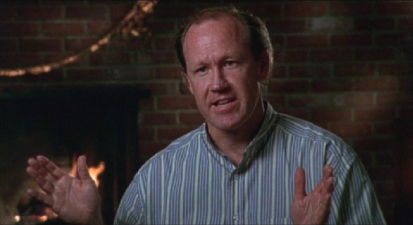
That the film stops to reflect on the magic these two gentlemen brought to a variety of the greatest animated motion pictures ever produced does not bog things down in the slightest. There’s always a comment or a story behind any of the clips, and it’s fun to hear what everyone thinks years after the events. There is, of course, also time for their private passions, and director Thomas (junior) is well equipped to deal with them in a personal way that never seems to encroach too much. Ollie (like Walt and fellow animator Ward Kimball) loves his trains, while we also get archive footage of Frank as the pianist in the popular band The Firehouse Five Plus Two (a group made up of fellow Disney artists who released several hit albums of their own and were caught on camera on numerous DisneyLand television specials).
Thanks to their insightful books, such as Disney Animation: The Illusion Of Life and The Disney Villain, Frank Thomas and Ollie Johnston have become the foremost and perhaps the most recognized of the Nine Old Men, but true to their disarming nature, it’s a distinction that the film never leans on to achieve effect. The two always share the same self-effacing attitude, joking about themselves as “the men who killed Bambi’s Mother”, a line that, while very amusing, does give away the slightly “scripted” nature of the film, meaning that although everything comes across spontaneously, one does get the feeling that some parts have either been set up or rehearsed. The early-morning putting the garbage out is one scene that sticks in mind. However, this really is as close to sitting in a room and watching your favorite animation sequences along with the original animators who drew them as one can get – and it’s sheer magic all the way.
The joy behind watching Frank And Ollie (and this is my fourth or fifth time), and this might sound corny, is their friendship. The two guys are inseparable, living next door to each other since way back when, sharing their highs, lows and entire lives with each other, and falling so much into each other’s grooves that never a bad word is said between them, nor a decision questioned. It’s especially poignant to see this 1995 film again with the knowledge that, in recent years, things haven’t been going as swimmingly for the duo, with Frank suffering a stroke and subsequent fall in 1998, and Ollie’s gradually slowing mobility leading to him having to sell off his prized locomotives.
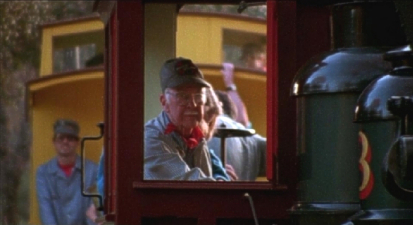
That the Disney company is so good at documenting their history, through archival footage, by conducting new interviews with legends from the past, and through continuing to greenlight films such as this, says a whole bunch about the current regime and their obvious admiration at what has come before (though sometimes that sentiment could be shot down with the plethora of dismal direct-to-video product – but that’s another review). The film itself, as directed by Theodore Thomas, resembles a very generously budgeted home movie, though the wonderful vintage footage (much seen before by the avid Disney fan), as well as the multitude of clips, lifts it above any amateur endeavour – this is classy stuff.
The two continue to make their mark on the animation of today, with references in Brad Bird’s The Iron Giant (at the scene of the train wreck, the engineers are caricatures of Frank and Ollie, while Ollie appropriately puts a voice cameo in), and in Mickey Mouse’s last featurette, Runaway Brain (1995), he is the unwitting victim patient of a certain Doctor Frankenollie!
While Walt: The Man Behind The Myth is more “epic” in scope (and it would be, considering that there’s a much larger story to tell), and The Hand Behind The Mouse: The Ub Iwerks Story flows slightly easier (probably due to both films having been narrated), Frank And Ollie drifts through its 90 minutes or so, carried by the charm of its subjects. There’s no big star narration this time around, but it’s just so great to effectively be able to spend a day with these two greats as they tell their own story that you’ll fall under the spell and not notice the time fly by.

Frank Thomas and Ollie Johnson are the last two of an original breed of craftsmen who dedicated themselves to pushing the animation envelope, stretching the boundaries of what could be achieved in the medium, and providing immeasurable entertainment to audiences of all ages and nations in the process. Though some of these animators continue to become slightly more “well known” to the average household (Ward Kimball, perhaps, especially), it’s always been Frank and Ollie who have publicly waved the flag for classic Disney animation, particularly through their books.
Though this film does not reveal any new “tricks of the trade” in the way that their books certainly do, we are treated to explanations direct from the horses’ mouths, as it were, on what exactly made their characters and scenes “tick”. As a documentary, Frank And Ollie remains a more than fitting, and very warm, tribute to two of Walt’s finest artists – the “Two Old Men”?
Is This Thing Loaded?
As with the Walt: The Man Behind The Myth disc, we are treated to an abundance of related and cut material from the feature documentary that almost adds up to the same again in running time length! That the film itself is the kind of doc one might expect to turn up as an extra on an older Disney title is not enough, it seems, and Disney have been very generous with the sheer amount on offer – all of it worthy and most certainly enhancing the main feature.
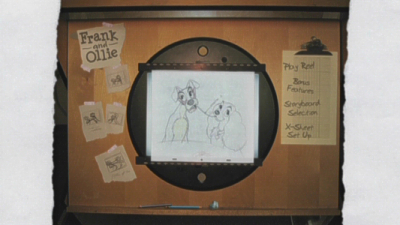
Pop the disc in, and we’re greeted to an absolutely gorgeous 16×9 enhanced (4×3 safe) main menu. Although totally different in style, I was reminded of the Fantasia Anthology menu, as they were obviously put together with care and attention, and as is the case again here. Each of the menus feature an “invisible hand” drawing out the layout of the menu in pencil, before it fills itself in to show a full color picture or design background, with the text options “written out” in the same way. The overall look and feel is that of an animators desk – very appropriate, very in keeping with the subject and the film, and very nicely done indeed. It made me all excited just loading the disc up!
Play Reel takes you to the widescreen feature, while Storyboard Selection takes us to a pin-board with scene options displayed as a series of Polaroids. X-Sheet Set Up is the subtitle options, as well as DVD Credits and another option to play the feature – all accompanied by the film’s jazzy score. Back to the main menu, and choosing Bonus Features takes us to the extras proper, offering a new selection of several options, with all video based clips shown in 4×3 full-frame.
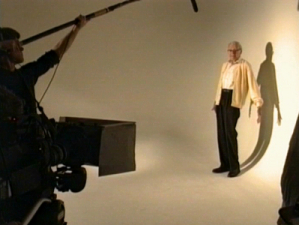
Making The Movie is a delightful mini-doc that centers more on director Thomas than the subjects. Here we see great footage of an early family home movie, featuring Frank as the villain, and behind-the-scenes shots of the actual documentary film being made, including a couple of gaffs! The on-set footage looks to have originated from a second unit VHS dub (the garbled lines of resolution at the bottom of the image are a giveaway, though this is not apparent on most TV screens), but it’s all in good shape. The eight-minute clip is narrated by Ted Thomas and is a nice little extra that adds a little background to the title characters in general, as well as filling us in on the director’s association with them too!
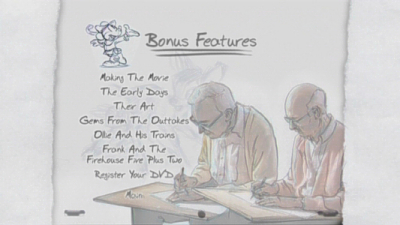
Back to the bonus menu, and The Early Days features another selection of informative and enlightening clips, each lasting just over two to three minutes. Firstly, John Canemaker On Winsor McCay has the historian discussing the pioneer animator’s contribution to the medium, featuring a brief look at Gertie The Dinosaur, setting up the basis of the world Frank and Ollie would help develop. In Ollie On Walt And Plane Crazy, Ollie examines the animation of the time and how Disney changed the way cartoon characters would “think” in the Mickey films, with sequences from the Ub Iwerks-animated short. Frank And Ollie’s Debut Scenes is just that: their first sequences for the Disney Studio. From the 1936 Mickey’s Elephant comes a Frank scene featuring Pluto (with some strange sound effects that sound suspiciously like they have been more recently mixed in), and Ollie’s debut with a brief 30-second clip from The Brave Little Tailor (Oscar nominee for 1938). Although these clips start with the original title cards, the full cartoons are not included (a shame, and how about a commentary with the guys on each?), though they are available on the Mickey Mouse: In Living Color Treasures tin.
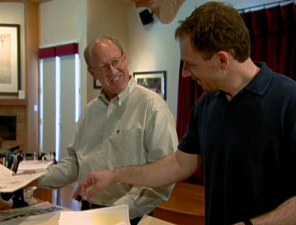
Next up is Their Art, which first sees Frank On Bringing A Character To Life, an insightful one-minute tip on Thomas’ approach to personality animation. Andreas Deja And Glen Keane On The Art Of Frank And Ollie has the pair elaborating on what has been said in the film, in a newly shot clip (2:20 minutes) that has them sifting through some actual production drawings from Lady And The Tramp, Peter Pan and The Fox And The Hound (Frank and Ollie’s last film, and Keane’s first for Disney). Arguably the Thomas and Johnston of their generation, it’s great to be able to hear Keane and Deja share their thoughts on the animation of yesteryear and how it compares with their work today. Following on from that clip, Andreas On Frank (5:12) has the animator picking scenes of King Louis, Madam Mim, Baloo and Mowgli, and Bernard from The Rescuers, describing how Frank’s use of motion brings life to the characters. In the same manner, Glen On Ollie (5:33) has Keane examining the influence of animator Freddie Moore on Frank and Ollie’s work, while picking scenes from Fantasia, Todd from The Fox And The Hound, Smee in Peter Pan, Pinocchio and Penny from The Rescuers to show how he was able to pick up Johnston’s technique and adapt it to his own style.
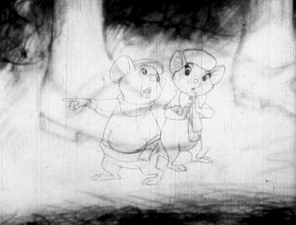
Evolution Of A Sequence takes a full scene from the Studio’s “crossover film”, The Rescuers (during which many of the Nine Old Men retired and passed the torch to Keane and co) and dissects it, from the early story reel, through Frank and Ollie’s notes to pencil testing. Although it firmly belongs here on this DVD, it’s a shame that it, or a similar feature, couldn’t have been included on this year’s earlier The Rescuers release, perhaps its more logical home. That said, it’s a fascinating look at the two men in action (there is also rough pencil animation of Snoops and Medusa from Milt Kahl among the storyboards), and for fans of the film this is absolutely great! All in all, the several clips on offer here add up to around 12 minutes, though another replay of the scene with completed color and music would have made a nice comparison.
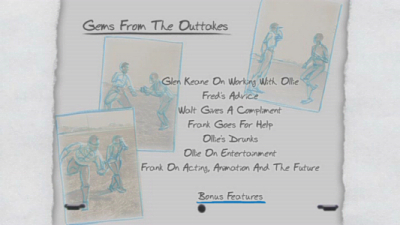
Gems From The Outtakes are not more shots of goofing off on set or interviews gone haywire, but rather a series of deleted scenes, cut for time from the main feature. Adding greatly to the information we have already seen, the extra scenes cover Glen Keane On Working With Ollie (2:15), Frank Thomas On Fred Moore’s Advice (1:02), Walt Gives A Compliment (52 seconds), Frank Goes For Help (1:05), Ollie’s Drunks (including Smee, Uncle Waldo and Sir Hiss, 1:43 mins), Ollie On Entertainment (1:37), and Frank On Acting, Animation And The Future (2:17).
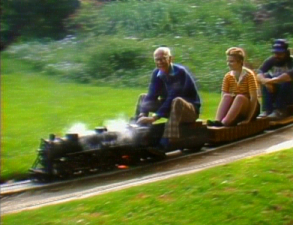
On to their personal lives and hobbies, and more scenes cut from the movie itself. Ollie And His Trains gives us an option, Ollie On His First Train Ride (54 secs), to hear from the man himself on what he finds fascinating about locomotion, while Ollie’s Trains features a couple of clips (combined to run just over three minutes) from the Disney Family Album (1985) and Animation Fascination (1983). Over in Frank And The Firehouse Five Plus Two, a couple of clips center on the Disney artists’ band, presenting us with the The FH5+2 Story (2:30), featuring much archival footage, and a rare performance clip from Jazz Scene USA (4:43), harking from 1962.
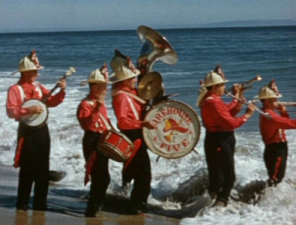
The only other program which would have been great to see included would be the 1981 television special The Illusion Of Life, hosted by Haley Mills and centering on Frank and Ollie’s book, as well as the making of The Fox And The Hound. Though it may turn up on a future Disney release, it would have made absolute sense here and simply been the icing on an already very layered cake. Another inclusion that was reported as a possible extra was the Runaway Brain cartoon starring Mickey Mouse (also from 1995), which pays homage to the two with the “Frankenollie” character. Note that, despite early claims, I couldn’t find the short on the disc anywhere, not even as an Easter Egg. However, on my attempts to dig something up, I did find an extra clip buried in the Firehouse Five Plus Two section: simply highlight “From Jazz Scene USA” and nudge across to the right to highlight a “hidden Mickey” symbol. Select this for a final 56-second, VHS dubbed clip on Frank and his valuable hands!
All in all, this is a very worthy edition, all the better for being put together by the team that made the film, as the DVD credits will confirm. The bonuses certainly add to the main feature, allowing us to see footage that was cut for timing purposes as well as the rare archival footage that fans like myself love to lap up. Although it’s a shame that those Walt Disney Treasure tins that were supposed to come out this December have been put back until next year, this Special Edition release of Frank And Ollie does go some way to soothing the disappointment, being a “treasure” all of its own!
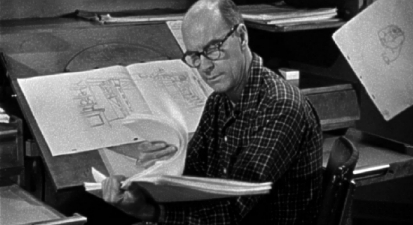
Case Study:
Although it’s not an animated classic, Disney has seen fit to issue Frank And Ollie in a traditional white keepcase. The cover art replicates that as seen on the original VHS release, using the colorful theatrical poster on the front of the sleeve. Inside, there’s a chapter index that utilises the same poster to good effect.
Ink And Paint:
Rescued from the pan-and-scan VHS treatment it initially received, Frank And Ollie is here presented in its original true 1.85:1 theatrical aspect ratio. Comparing the two releases, it’s clear that this framing is the right choice: the film was shot at 1.66:1, which clips a small amount North and South here, but opens up a very noticeable amount on the sides. Most of the early archive footage has been blown up and re-framed to accommodate the wider composition, but the sequences from the numerous animated films retain their original ratios by way of “windowboxing” the image, so that the full beauty of the animation can be observed. Although the doc was made fairly cheaply, the print used is in good overall shape, and looks to be the same minted for the earlier tape transfer. Compared to the VHS, the DVD looks decidedly darker in tone, though this is probably how the film was meant to look, as the film sequences are the same texture throughout, and no image information is lost to shadow. Frank And Ollie was shot on 16mm film stock, blown up to 35mm, and has been transferred very nicely to disc.
Scratch Tracks:
Mainly talking head dialogue with the two, Frank And Ollie is not a film designed to blow your speaker system apart! But here you’ll find fantastic fidelity in the voices and a depth to the interview sections that would rival any other voice-based project. On video, the film was presented in Dolby Surround, though you’ll rarely hear the rears perk up. Instead, any such activity is reserved for the clips and music, scored by John Reynolds in a jazzy style similar to Frank’s playing in The Firehouse Five Plus Two. Everything sounds spot on, and even the mono archive clips have had a clean-up pass or two, so that they fit in as well as can be. English subtitles are also included.

Final Cut:
Two down, two to go. I’ve always felt that the Walt and Iwerks documentaries, and this film, were all part of an unofficial “legacy trilogy” which took in the important factors of why Disney is still where it is in the scheme of things today. To that list, one could add The Sweatbox, an insider’s look at the production of a big contemporary Disney feature (2000’s The Emperor’s New Groove) and how these films really twist and turn through development. It certainly would make an interesting conclusion to the first three titles, which as a collection would end up examining the very beginnings and foundations of the company that Walt built, and seeing it through to a major release from today’s staff.
Frank And Ollie probably fit somewhere in the middle, after Ub had laid the basics for personality animation and had moved on to the technical aspects, leaving the then nine young men to develop that approach and get on with the day-to-day business of creating hand drawn magic. As two of the leaders of that crowd, Frank and Ollie set their own standards (witness the attempt to imitate their classic Baloo The Bear in The Jungle Book with the faded impression of the same character in the recent sequel). The “Doctor Frankenollie” gag pretty much sums it up: their names roll off the tongue in that way, locked together just as the men themselves in their actual lives are. Ollie needs Frank, and Frank needs Ollie. Together, they created some of the most memorable images and emotional moments ever put on screen. And this documentary adds to them – a real “must”!
 | ||
 |








